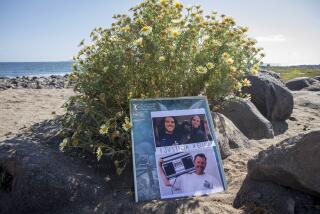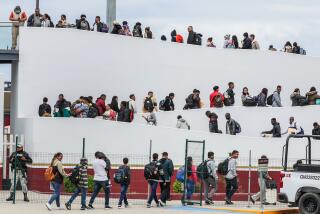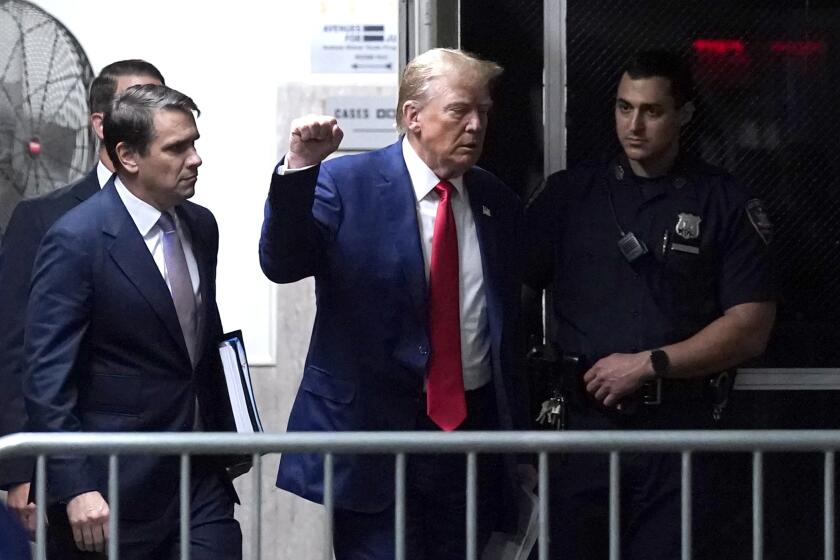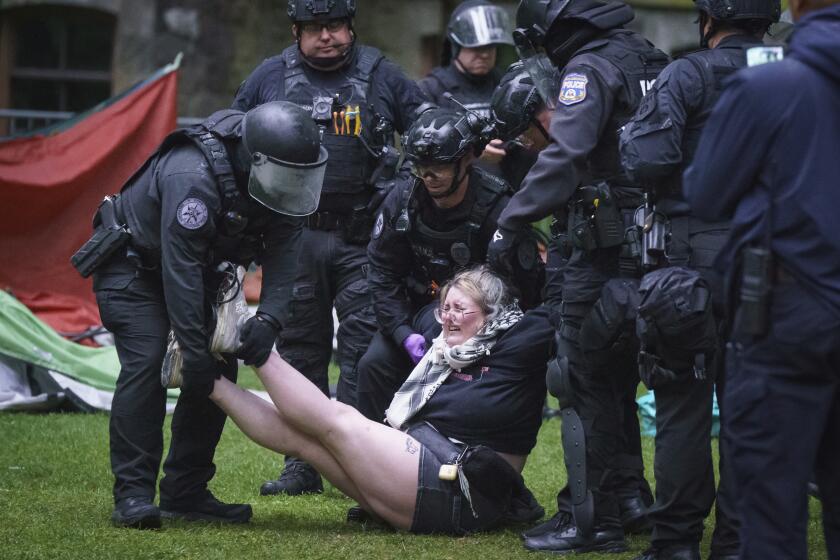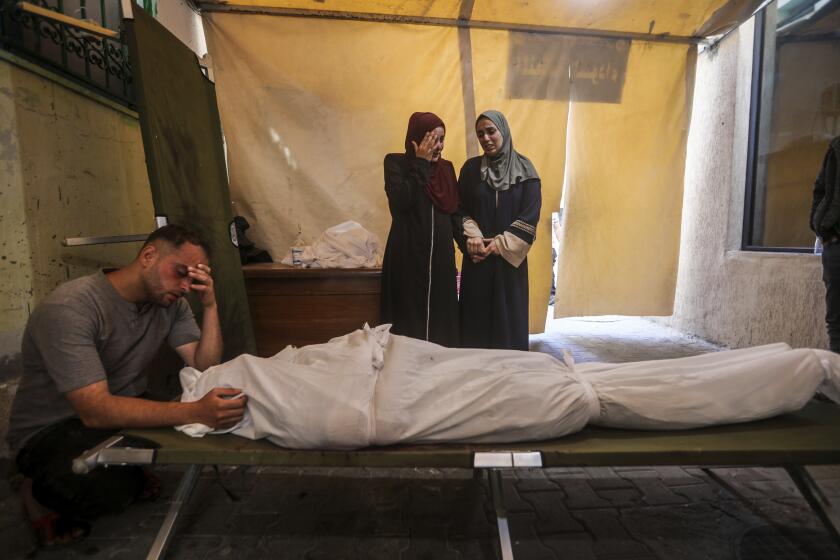Boston’s Youth Violence Program Becomes Model for Nation
Not so long ago, the shooting deaths of two young people over a two-day span would have seemed tragic--and grimly routine. But a pair of seemingly unrelated drive-by killings that claimed the lives of two male teenagers here this month garnered unusual attention.
“It unnerved people,” said Police Officer Kenneth Israel, a member of Boston’s nationally acclaimed Youth Violence Strike Force.
“They’re used to the streets being quiet. They’re used to their kids being out there.”
At district headquarters in Roxbury, one of Boston’s roughest neighborhoods, Israel’s commanding officer was philosophical.
The two shooting deaths were unfortunate, Lt. Gary French said, “but it’s going to happen. We went 2 1/2 years without any. Whether you like it or not, it’s going to happen. We’ve just got to try to prevent as many as we can.”
Homicide rates have been declining nationally among those ages 15 to 24, the target population for French’s unit.
Figures from the National Center for Health Statistics show that between 1993 and 1995, the most recent years for which data have been compiled, firearm deaths for young people dropped as much as 15% in some regions.
Still, the figures were up sharply from a decade earlier, and guns continue to be the primary mechanism for homicide. In 1995, firearms accounted for 84% of young peoples’ killings, compared with 66% in 1985.
Federal officials credit the drop in youth homicides to a tougher judicial system, higher incarceration rates, changing drug markets and heightened community activism.
With its powerful program of collaboration between police and probation departments, street workers, business organizations, health centers, schools, religious leaders, the mayor’s office and residents who are determined to own their streets, Boston is a virtual laboratory for that formula.
“People keep looking for one component, one reason that the coalition is working here,” French said. “They say it’s the police and the probation officers working together.
“But they miss the whole picture,” he said. “They forget about the more than 900 crime watch groups we have in this city. They forget about the health centers, the street workers, the property management companies and the DARE officers. They forget about the individual old ladies in the neighborhoods who take these kids in after school. There are all sorts of things working together.”
But residents are less analytical. The sense that the streets are once again safe has produced a mood approaching jubilation. Mothers regularly thank police and probation officers for their enforcement efforts. The youth strike force inspires such pride that a group of young graffiti artist--the very kids officers might once have busted--showed up to spray-paint a mural at police headquarters.
Like all good theorems, the formula for success in Boston also rests on a rock-solid equation, French said: “Equal parts prevention, suppression and intervention.”
*
In Memphis, among other cities, officials are looking to adapt Boston’s youth violence strategy to the problem of domestic violence. At the Rand Corp. in Santa Monica, social scientist Peter Greenwood is studying whether the Boston model could apply to Los Angeles.
Police officials have made three visits to the White House, most recently in July, when President Clinton singled out Boston while speaking out against youth gun violence.
Juvenile homicide was never a huge problem in Boston. In the most deadly year in recent record, 10 young people were killed. Under the law, a “juvenile” is defined as someone younger than 16.
Despite the low numbers, a mood of fear and frustration nonetheless gripped much of the city. In Roxbury and nearby Dorchester, gang warfare was a regular occurrence. The gangs were small and local, but the Intervale Posse or the Magnolia Street Steelers wielded terror nonetheless.
In 1995, the Gun Project Working Group was launched, drawing on police officers, city officials, academics and community representatives.
The group spent nearly a year chewing its way through the dynamics of violence here. What was distinctive about this process, said David Kennedy, a senior researcher at Harvard’s John F. Kennedy School of Government, “was that for the first time in any American city, people actually took the time to find out what it was that they were dealing with. They actually did their homework.”
Up to that point, Kennedy explained, “Boston was chock-a-block with remarkably serious, dedicated, visionary people working with this problem.”
But everyone looked at pieces, he said, or jumped in with the latest brilliant innovation before considering the context. Probation officer Randy Haynes, an early member of the strike force, said the project also spurred conversation across many lines of the city.
Delegates from the police, the clergy, the probation department and the district attorney’s office also began talking directly to gang members, their families, their friends and their neighbors. “The key turned out to be sitting down and saying ‘Look, the violence stops--and if it doesn’t stop, we’re going to enforce every law we’ve got,’ ” Police Commissioner Paul Evans said.
At first the violence didn’t stop. True to their word, officials swept in, calling on the National Guard to level a wooded area that had become gang territory. Twenty-three Intervale Posse members were sent to jail, a substantial dent in the gang’s roster. Police also heeded the recommendations of church leaders who considered some kids too violent to be on the street.
“They’re very realistic,” French said of those in the religious community. “They know you can’t save every kid. They’d rather counsel him in prison than do a funeral for one of his victims.”
In September 1996, soon after the Intervale sweep, “the streets changed,” Kennedy said. For those younger than 25, he said, gun deaths since then have been running at 75% below their previous average. He stressed, however, that social scientists balk at assigning a single cause to the decline.
The dearth of crime soon became a happy habit, Sgt. Det. Margot Hill said. “People got used to the idea that they could send their kids out at night,” she said. When the 2 1/2-year stretch without a youth lost to gunfire was broken in December, “people went ballistic,” Hill said, adding, “We didn’t realize how personally and profoundly they took it.”
Out on the streets, Officers Mark Freirie and Jimmy Rattigan speak earnestly about the collaborative nature of their work.
Both are members of Operation Night Light, plainclothes officers who patrol the streets at night. His early police training taught them to target and arrest “one or two individuals,” said Freirie, 36. “Now we’ll go in, watch them, identify them--and we’ll move in on a sweep, taking 25 guys at a time.”
Housing management companies are especially helpful, Rattigan said, vacating apartments that gaze out on troubled areas so police can have a neighborhood foothold. He also praised probation officers who pay surprise visits to homes.
Freirie and Rattigan expressed enthusiasm for the newest component of the youth antiviolence project, a 2-to-6 p.m. after-school program developed by Mayor Tom Menino’s office that debuts next month.
“It used to be that you didn’t have time to get a sandwich,” Freirie said. “You went from shooting to stabbing to stickup, then back again.”
By contrast, on a recent night last week, the pair cruised by a former gang hideaway and saw a girls’ volleyball game in progress. The worst event of the evening was a non-injury traffic accident.
Still, the two back-to-back drive-by killings earlier this month offered “a reminder,” Rattigan said, “that we got our work cut out for us.”
More to Read
Start your day right
Sign up for Essential California for news, features and recommendations from the L.A. Times and beyond in your inbox six days a week.
You may occasionally receive promotional content from the Los Angeles Times.
